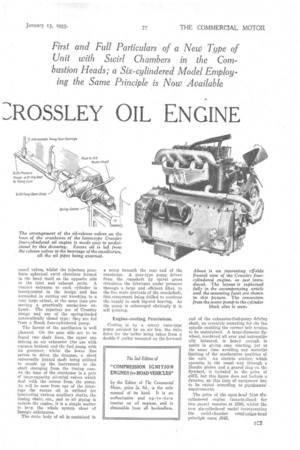New Principle in
Page 40

Page 41

If you've noticed an error in this article please click here to report it so we can fix it.
THE LATES1
1:ROSSLEY OIL ENGINE WE are able this week to announce a new type of Crossley compression-ignition engine to be manufactured alongside the six-cylindered oil engine which has now been in production at the works of Crossley Motors, Ltd., Gorton, Manchester, for about two years. The new model is available in two sizes, one having four and the other six cylinders, the bore and stroke dimensions being identical; furthermore, these dimensions are the same as those of the six-cylindered type already being produced, so that any operator who has a fleet of Crossley oil-engined vehicles could augment it by fourcylindered models without having to curry a greatly increased stock of spares, such items as pistons and rings, connecting rods, gudgeon pins, valves, springs, push-rods, rockers, etc., being standardized components.
The four-cylindered model is to be used in certain Crossley vehicles, but great care has been taken in the design to make it suitable for converting
petrol-engined machines ; the unit is compact and, due to the fact that facing strips are provided at the forward end of the crankcase and on the flywheel housing, special engine feet can easily be made for adaptation to existing vehicles. The engine, which develops 66 b.h.p. at 1,700 r.p.m., weighs, with dynamo, air exhauster, starter motor and oil, under 12i cwt., and as the overall length is but 3 ft. 9 ins, and the width 2 ft. 5 ins., little installation difficulty should he experienced in any vehicle of sufficient size to warrant the use of an engine of this size.
Capacity and Torque Figures.
With bore and stroke dimensions of 4-F6 ins. and 6 ins., the piston-swept volume works out at 371 cubic ins., or 6.085 litres. As will be seen from the accompanying power curve, the torque and b.m.e.P. curve has a remarkably fiat contour, the maximum torque being around 2,600 lb.-ins. at 1,000 r.p.m., whilst even at 1,600 r.p.m. the torque figure is 2,500 lb.-ins. Like that of the six-cylindered unit, the crankshaft has a bearing between each pair of throws and is a really sturdy unit; there Is a vibration damper at the forward end of the shaft to take care of torsional oscillations. The crankcase is moulded from a special aluminium alloy and is of stiff section, being deep and well ribbed internally, whilst the case is relieved of the major stresses by continuing the main-bearing bolts through to the cylinder block. The crankshaft itself is machined all over, the journals and pins being ground and lapped. There are balance weights incorporated in the crankshaft stamping, one on the opposite side to each throw, thereby relieving the crankshaft of certain inertia stress.
In design the cylinder block is much the same as the six-cylindered type, a monobloc casting with renewable airhardened liners—an arrangement which not only makes replacement a simple and inexpensive matter, but ensures freedom from distortion when the engine is running under heavy service condi A single casting embraces all four cylinder heads and the vertically dis posed valves, whilst the injectors penetrate spherical swirl chambers formed in the head itself on the opposite side to the inlet and exhaust ports. A venturi entrance to each cylinder is incorporated in the design and has succeeded in cutting out knocking to a very large extent, at the same time preserving a practically smoke-free exhaust. The injectors are of Crossley design and are of the spring-loaded automatically closed type; they arc fed from a Bosch four-cylindered pump.
The layout of the auxiliaries is well planned. On the near side are to be found two shaft lines, the upper one driving an air exhauster (for use with vacuum brakes) and the fuel pump with its governor, whilst the lower line serves to drive the dynamo, a short universally jointed shaft being utilized to couple up the instrument to the shaft emerging from the timing case. At the base of the crankcase is a pair of large-capacity oil-relief .valves which deal with the excess from the pump. As will be seen from one of the drawings the excess ell is utilized for lubricating various auxiliary shafts, the timing chain, etc., and as all piping is outside the engine, it is a simple matter to keep the whole system clear of foreign substances.
The main body of oil is contained in
a sump beneath the rear end of the crankcase. A gear-type pump driven from the camshaft by spiral gears circulates the lubricant under pressure through a large and efficient filter, to the five main journals of the crankshaft, this component being drilled to continue the supply to each big-end bearing. As the pump is submerged obviously it is self priming.
Engine-cooling Provisions. .
Cooling is by a rotary vane-type pump assisted by an air fan, the twin drive for the latter being taken from a double-V pulley mounted on the forward end of the exhauster-fuel-pump driving shaft, an eccentric mounting for the fan spindle enabling the correct belt tension to be maintained. A large-diameter flywheel, machined all over and automatically balanced, is heavy enough to assist in giving easy starting, yet at the same time avoiding any material limiting of the accelerative qualities of the unit. An electric starter, which operates in the usual way through a Bendix pinion and a geared ring on the flywheel, is included in the mice of £475, but this figure does not include a dynamo, as this item of equipment -has to be varied according to purchasers' requirements.
The price of the open-head typo Sixcylindered engine (standardized for two years) remains at £595, whilst the new six-cylindered model incorporating the swirl-chamber combustion-head principle costs £645.




























































































